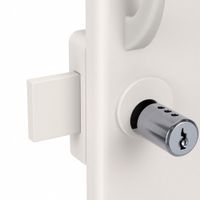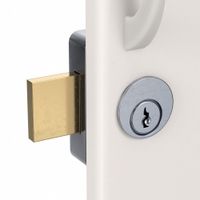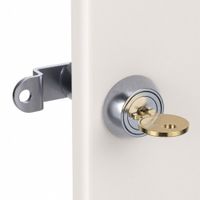Call +(254) 703 030 000 / 751 483 999 / 721 704 777
.....Read More
Frequently Asked Questions
How do I install a cam lock on a cabinet or drawer?
1. **Gather Materials**: Obtain a cam lock kit, drill, drill bits, screwdriver, measuring tape, pencil, and safety goggles.
2. **Choose Location**: Decide where the cam lock will be installed on the cabinet or drawer. Typically, it is placed on the top corner of a cabinet door or the center of a drawer front.
3. **Measure and Mark**: Use the measuring tape to find the center point for the lock. Mark this spot with a pencil.
4. **Drill Hole**: Select a drill bit that matches the diameter of the cam lock barrel. Drill a hole through the marked spot. Ensure the hole is straight and clean.
5. **Install Cam Lock**: Insert the cam lock barrel into the hole from the front. The lock face should be flush with the surface.
6. **Secure with Nut**: From the inside, slide the retaining nut over the barrel and tighten it using a wrench or pliers. Ensure the lock is secure and does not wobble.
7. **Attach Cam**: Place the cam (the metal arm) onto the back of the lock barrel. Secure it with the provided screw. The cam should rotate freely when the key is turned.
8. **Test Lock**: Insert the key and turn it to ensure the cam moves correctly and locks the cabinet or drawer securely.
9. **Adjust if Necessary**: If the cam does not align properly with the strike plate or catch, adjust its position by loosening the screw, repositioning the cam, and retightening.
10. **Final Check**: Test the lock several times to ensure smooth operation and security.
11. **Clean Up**: Remove any debris from drilling and store tools safely.
What tools are needed to install cabinet and drawer locks?
To install cabinet and drawer locks, you will need the following tools:
1. **Drill**: Essential for creating holes in the cabinet or drawer where the lock will be installed.
2. **Drill Bits**: Various sizes may be needed depending on the lock type and size.
3. **Screwdriver**: Used to secure screws that hold the lock in place. Both flathead and Phillips screwdrivers might be necessary.
4. **Measuring Tape**: For accurate measurement of the lock placement to ensure proper alignment and fit.
5. **Pencil or Marker**: To mark the spots where holes need to be drilled.
6. **Chisel**: Useful for mortising or creating recesses for certain types of locks that require a flush fit.
7. **Hammer**: May be needed to gently tap the chisel or to adjust the lock components.
8. **Square or Level**: Ensures that the lock is installed straight and aligned properly.
9. **Awl or Center Punch**: Helps in marking the exact spot for drilling, preventing the drill bit from slipping.
10. **Pliers**: Useful for holding small parts or bending components if necessary.
11. **Safety Glasses**: Protects your eyes from debris while drilling or chiseling.
12. **Dust Mask**: To avoid inhaling dust particles during drilling.
13. **Template or Jig**: Some locks come with a template to guide the installation process, ensuring precision.
14. **File or Sandpaper**: For smoothing out rough edges after drilling or chiseling.
15. **Lock Installation Kit**: Some locks come with a specific kit that includes necessary components and instructions for installation.
Having these tools on hand will facilitate a smooth and efficient installation process for cabinet and drawer locks.
How do I choose the right lock for my furniture?
To choose the right lock for your furniture, consider the following factors:
1. **Type of Furniture**: Identify the furniture piece you need to secure, such as cabinets, drawers, or wardrobes. Different furniture types may require specific lock designs.
2. **Lock Type**: Choose from various lock types like cam locks, deadbolt locks, or electronic locks. Cam locks are common for cabinets and drawers, while deadbolt locks offer more security for larger furniture. Electronic locks provide keyless entry and are suitable for modern furniture.
3. **Material Compatibility**: Ensure the lock is compatible with the furniture material, whether wood, metal, or glass. Some locks are specifically designed for certain materials.
4. **Security Level**: Determine the level of security needed. For high-value items, opt for locks with advanced security features like anti-pick or anti-drill mechanisms.
5. **Ease of Installation**: Consider locks that are easy to install, especially if you plan to do it yourself. Some locks require professional installation.
6. **Aesthetic Match**: Choose a lock that complements the furniture’s design and finish. Locks come in various styles and finishes to match different aesthetics.
7. **Key Management**: Decide between keyed and keyless options. Keyless locks eliminate the need for physical keys, reducing the risk of losing them.
8. **Budget**: Set a budget and find a lock that offers the best security within your price range. Higher-priced locks often provide better security features.
9. **Brand and Reviews**: Research reputable brands and read customer reviews to ensure reliability and durability.
10. **Warranty and Support**: Check for warranty and after-sales support, which can be crucial if the lock malfunctions.
By considering these factors, you can select a lock that effectively secures your furniture while meeting your specific needs and preferences.
Can I install a lock on an existing piece of furniture?
Yes, you can install a lock on an existing piece of furniture. First, determine the type of lock suitable for your furniture, such as a cam lock, hasp lock, or drawer lock. Measure the area where you plan to install the lock to ensure it fits properly. Gather necessary tools like a drill, screwdriver, and measuring tape. Mark the spot where the lock will be installed, ensuring it aligns correctly with the locking mechanism. Drill holes as needed, following the lock's installation instructions. Attach the lock components, securing them tightly. Test the lock to ensure it functions smoothly. If needed, make adjustments for a perfect fit.
How do I rekey a cam lock or cabinet lock?
To rekey a cam lock or cabinet lock, follow these steps:
1. **Gather Tools and Materials**: You'll need a screwdriver, a rekeying kit specific to your lock brand, and the current key.
2. **Remove the Lock**: Use the screwdriver to unscrew and remove the cam lock from the cabinet or drawer. Keep all screws and parts organized.
3. **Disassemble the Lock**: Insert the current key and turn it to the unlocked position. Use a follower tool from the rekeying kit to push the plug out of the lock cylinder carefully. Ensure the pins and springs do not fall out.
4. **Replace the Pins**: With the plug removed, take out the old pins. Use the rekeying kit to match new pins to the new key. Insert the new pins into the plug, ensuring they align with the shear line when the new key is inserted.
5. **Reassemble the Lock**: Carefully reinsert the plug into the lock cylinder, ensuring the pins and springs remain in place. Use the follower tool to guide the plug back into position.
6. **Test the New Key**: Insert the new key and turn it to ensure smooth operation. The lock should open and close without resistance.
7. **Reinstall the Lock**: Place the rekeyed lock back into the cabinet or drawer. Secure it with screws, ensuring it is tightly fitted.
8. **Final Check**: Test the lock with the new key to confirm it functions correctly. Make any necessary adjustments.
By following these steps, you can successfully rekey a cam lock or cabinet lock, ensuring only the new key operates it.
What are the differences between cam locks and cabinet locks?
Cam locks and cabinet locks serve different purposes and have distinct features:
1. **Design and Structure**:
- **Cam Locks**: These are simple locking mechanisms consisting of a base and a cam, which is a flat, rotating piece. When the key is turned, the cam rotates to lock or unlock.
- **Cabinet Locks**: These are more complex and can include various types such as deadbolts, latch locks, or even electronic locks. They are designed specifically for securing cabinet doors or drawers.
2. **Usage**:
- **Cam Locks**: Commonly used in furniture, mailboxes, lockers, and small enclosures. They are ideal for applications where a simple locking mechanism is sufficient.
- **Cabinet Locks**: Specifically used for securing cabinets, they can be found in kitchens, offices, and storage areas. They provide more security and are often used where valuable items are stored.
3. **Security Level**:
- **Cam Locks**: Offer basic security, suitable for low-risk applications. They are not designed to withstand significant force or tampering.
- **Cabinet Locks**: Provide higher security, often featuring more robust materials and mechanisms. Some may include additional security features like key control or electronic access.
4. **Installation**:
- **Cam Locks**: Easy to install, requiring minimal tools and expertise. They are often surface-mounted.
- **Cabinet Locks**: Installation can be more complex, sometimes requiring professional assistance, especially for electronic or integrated systems.
5. **Variety**:
- **Cam Locks**: Limited in variety, mainly differing in size and finish.
- **Cabinet Locks**: Available in a wide range of types, including keyed, combination, and electronic versions, catering to different security needs.
In summary, cam locks are simpler and used for basic security, while cabinet locks offer more options and higher security for protecting valuable items.
How do I maintain and lubricate locks to ensure longevity?
To maintain and lubricate locks for longevity, follow these steps:
1. **Regular Cleaning**: Use a soft brush or compressed air to remove dust and debris from the lock's exterior and keyhole. This prevents dirt accumulation that can hinder lock function.
2. **Lubrication**: Apply a graphite-based lubricant or a dry Teflon spray. Avoid oil-based lubricants like WD-40, as they can attract dust and grime. Insert the lubricant into the keyhole and other moving parts, then operate the lock several times to distribute it evenly.
3. **Key Maintenance**: Ensure keys are clean and free from burrs. A damaged key can wear down the lock mechanism. If a key is bent or worn, replace it to prevent damage.
4. **Inspect and Tighten**: Regularly check the lock and its components for wear or looseness. Tighten any loose screws or bolts to ensure the lock is securely mounted.
5. **Weather Protection**: For outdoor locks, use weather-resistant covers to protect against moisture and extreme temperatures. Consider using a silicone-based lubricant for added protection against rust and corrosion.
6. **Periodic Checks**: Test the lock's operation periodically. If you notice stiffness or difficulty turning the key, it may be time for cleaning and lubrication.
7. **Professional Servicing**: For complex locks or if issues persist, consult a professional locksmith for servicing. They can provide specialized maintenance and repair.
By following these steps, you can ensure your locks remain functional and secure for an extended period.





